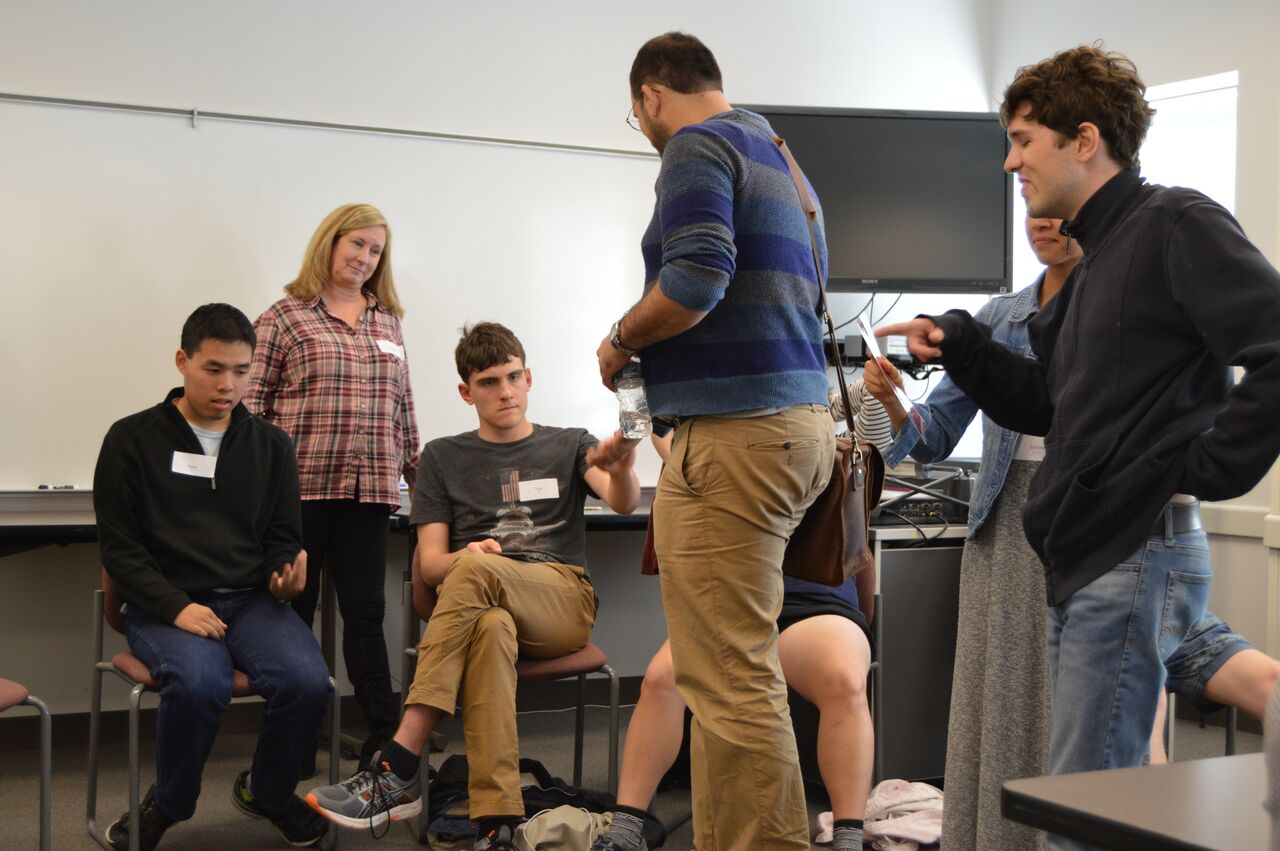There are many reasons why I love being so involved with Tribe, but the UVa-Tribe exchanges are at the top. As a UVa alum, a friend of Vikram (who teaches the course), and as an educator at GKTC, it’s truly the case of my worlds colliding, and it’s the best thing ever.
GKTC Tribe and UVa undergraduates met on October 28, 2017 for their second exchange in The Science and Lived Experience of Autism collaboration. The theme of the year-long collaboration is Creating Welcoming Communities.


In Exchange 1, the students discussed what makes people feel welcome or unwelcome. Following the design thinking process from a separate collaboration with the University of Maryland over the summer, we discussed how to redesign the meet-and-greet experience, which tends to be pleasant small talk at best. In Exchange 2, the students discussed what comes next – “making meaningful social connections and developing friendships.” We welcomed Assistant Professor of Psychology, Matt Lerner, from Stony Brook University, who studies friendship in speaking ASD adolescents.
We kicked off the first round of discussions by comparing how neurotypical people express their interest in social situations:
Ian: I know that there are a lot of expectations during conversation, like eye contact.
Sam (UVA): Facial expression
Flo (UVA): Body language
Madison (UVA): Voice intonation
Ben: Getting a smile from a stranger
Katie (UVA): Asking questions and being active listener
Emma: Leaning in


Tribe then shared their experiences, particularly not being able to control their body to show interest in a typical way even though they are very much interested and engaged.
Ryan: How most people interpret my behaviors is very different than I intend.
Ben: I always mean to look interested in others but I do not always meet others’ expectations. Hard enough to make my speech understood, much less make my hardheaded body comply.
Tom: My mouth is always saying something. Please don’t mistake it as a sign of my intelligence.

What Vikram said in his group summarized things well: “We expect socially interested people to behave in certain ways because that is how we behave – when we’re happy/sad we look like this, expect others to do the same. We all recognize that just because someone doesn’t behave in certain way, doesn’t mean they’re not interested.”
We also discussed social competence, which can be summarized as:
Flo (UVA): Being flexible in different contexts and having an awareness of social standards;
and
Madison (UVA): understanding the needs of your surroundings and needs of other people and matching the needs between them.
Tribe shared their thoughts and experiences as nonspeaking autistics regarding studies that say speaking autistics take more time to process social cues.
Emma: No, [processing social cues is] not difficult, Huan can explain.
Huan: I’m with Emma, having a body that’s uncooperative has its upsides, like being able to process information in our brains rapidly.
Ian: I am completely capable of reading people’s social cues and understanding in the moment. It’s not slow processing, it’s a non-reliable body. What you see is not always what I feel.

Matt added to the part of the discussion where we discussed other factors that might affect how socially interested we look: “I think another reason for this is that a person can have competing intentions in the same situation and can resolve behavior into one overriding intention. I’m here and I want to be social or I’m here and don’t want to be social. Say you are at a party with your boss and you want to be social but you are afraid of approaching him. These variables are not static.”
Elizabeth made a good point in response: “We tend to love static variables. How you might socialize in this class environment is very different than how you would socialize at a party with friends or even a dinner party your parents are throwing.”
Given our discussions of social competency (the standards of which were created through an NT lens) and the stories Tribe has shared, we can begin to reset expectations and the NT’s understanding of nonspeaking individuals and their perceived sociability.
After lunch, we came together as a large group and shared out what was discussed in the breakout discussions. While we were talking about the social standards that society has set for autistic people to achieve, the social skill competencies we’ve built into IEPS, I was reminded of a quote Lisa had shared almost a couple of years ago: “I would just say just treat me the way you want to be treated.” In the moment I didn’t think of it, but Matthew also shared something along the same lines: “To my peers, we are both people so just treat me like a person.” We’ve created these lists of skill sets that we emphasize as necessary to demonstrate social competence. There are standards that we push the neurodiverse to reach, but there is also another standard for the neurodiverse AND neurotypical alike: the human standard – to be treated and respected as a human being and to treat and respect others as human beings. Elizabeth added, “What power was vested in us as NT that makes us think we are the litmus of all things socially appropriate?”


The remainder of the large group meeting was a Q&A panel with Tribe and Matt:
Ian: I was wondering if we broke any stereotypes about non-speakers than you may have believed
Matt: I have spent a lot of time with nonspeaking people so I try not to have stereotypes. One that stands out, that I’m sure you know, is that your bodies aren’t always doing what you want them to do. I think there is a stereotype that you aren’t paying attention. I think what you all show is that even if you are playing Angry Birds or making sounds it doesn’t mean you aren’t paying attention or listening. I think you broke the stereotype in a big way so thank you.
Huan: I want to know if Matt thinks we’re socially competent.
Matt: I have a confession. I have a lab called the social competence lab. I’m still not sure I know what social competence is. You guys tried to define it earlier today and I’ve read almost everything I can on the topic. I think that social competence is about meeting your own goals. I think it depends on what your goals are Huan, it depends on your standards and that’s what matters.
Huan: Absolutely, yes
Ryan: I’m curious to know if and how NTs are taught to interact with autistics
Matt: It doesn’t happen too much. I think the places it happens are very variable. I think the ones you are having is rare. I teach a class at Stony Brook with 200 undergraduates and they read the research. I make sure 1/3 of the class is autistic. Most of the ways people are taught to interact with autistics is through clinical training and speech pathology. I don’t think we have yet achieved a standardized way that that happens. Some fields do better than others. So Ryan, to answer your questions, not enough. This is why we need good science in order to come up with ways to make training more inclusive.


The students broke out into their project groups for the remaining time to discuss specific aspects of creating more welcoming and inclusive communities, communities in which nonspeaking autistic individuals can “be accepted as me and treated like you,” as Ryan shared. Look forward to their projects about preventing bullying/harassment, housing options, supporting transition to higher education and providing employment!

Until next time!
~ Janine Abalos and The Tribe
